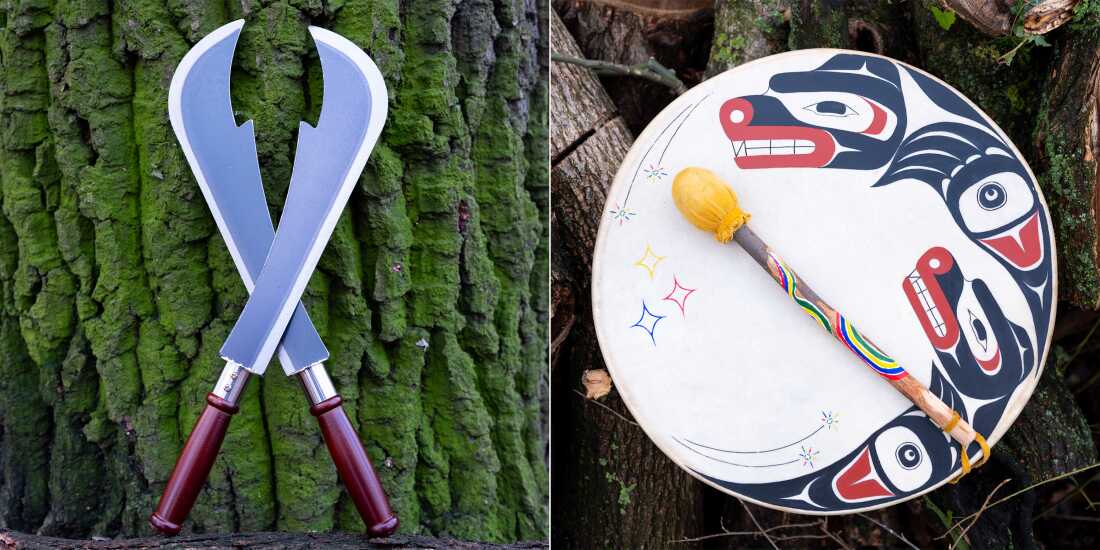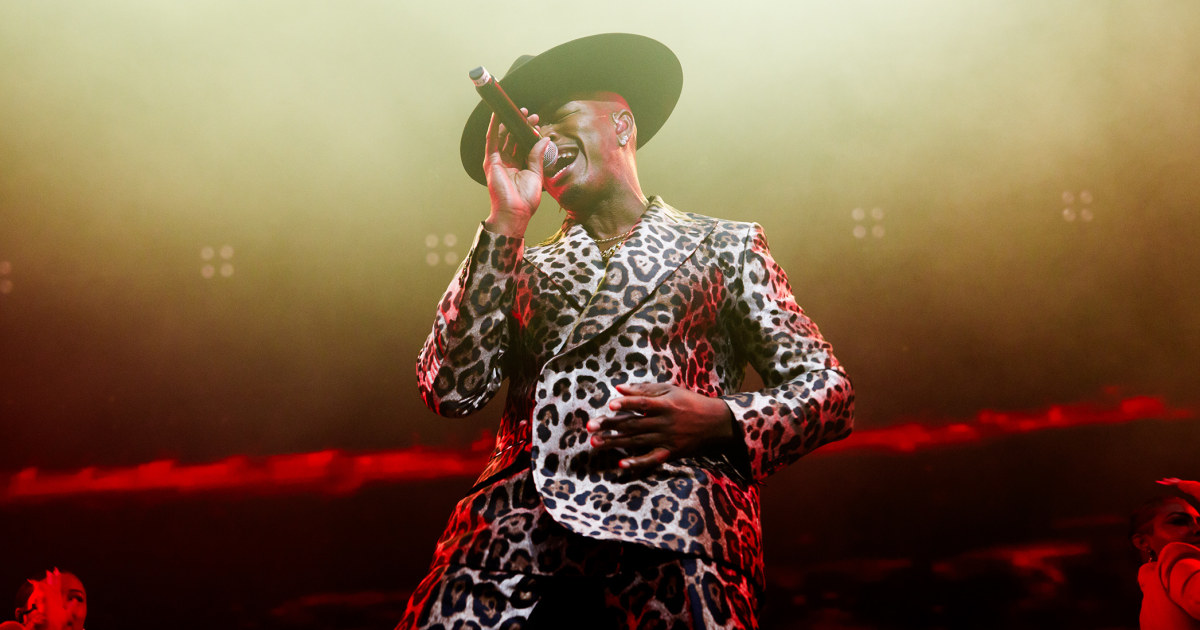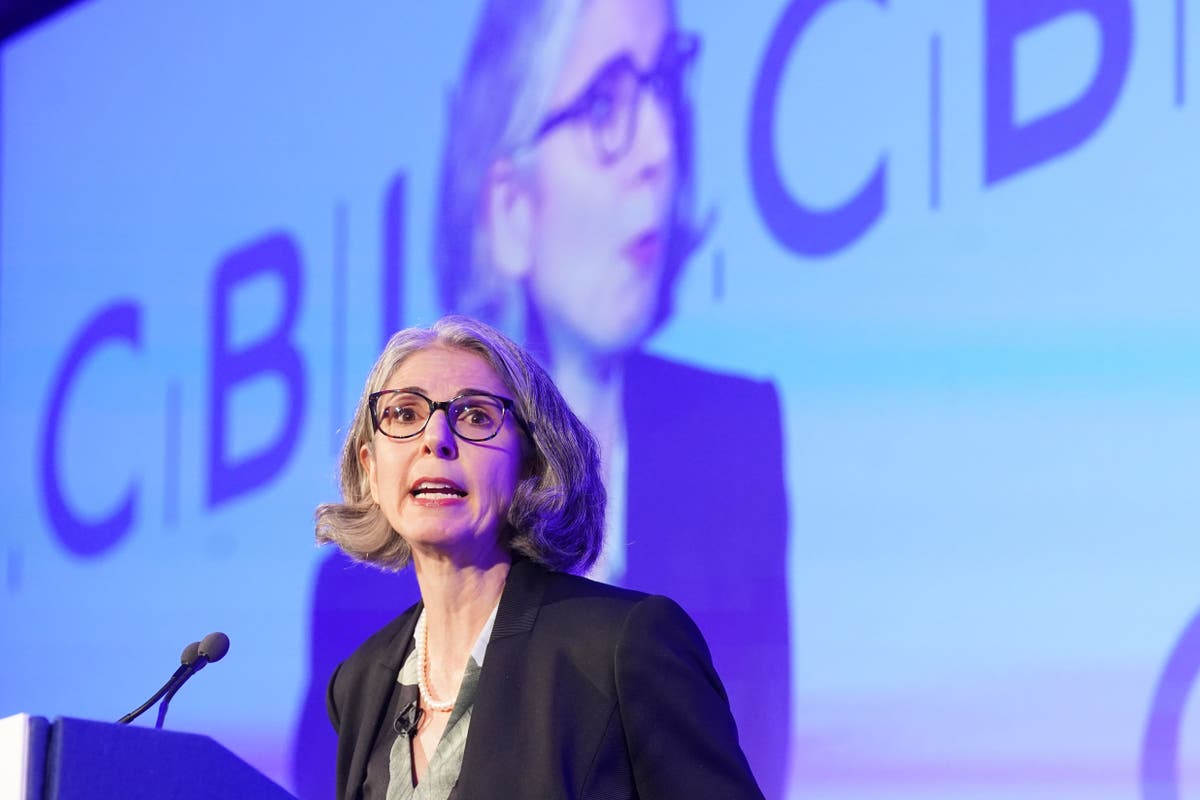World
How one shaman helps others find healing and meaning in a modern world

Helena Soholm holds up the five directional flags of Korean shamanism in Dronningmølle, Denmark.
Arin Yoon
hide caption
toggle caption
Arin Yoon
It is the day before the ceremony and forty people from different parts of the world will converge in Copenhagen to experience a shamanic ceremony facilitated by 46-year-old Helena Soholm, a Korean American shaman, called mudang in Korean.
In wanting to know more about shamanism, I came across Helena’s work. Now we are together in North Zealand, Denmark, along with traditional Korean musician Dong-Won Kim, 58, who will accompany Helena during the ceremony.
When we arrive on the beach, it is still a little overcast and the earth is frozen under a thick, white carpet of snow. Dong-Won looks out and announces, “The sea welcomes us.” I say to Helena, “Sorry, I wanted to do more research about shamanism before the trip, but I just didn’t have time.” She responds, “Arin, that’s a colonial way of looking at shamanism. You learn about it by experiencing it.” Helena and Dong-Won bow to the five directions during a pre-ceremony ritual. Center is the fifth direction.

Left: An offering of Korean soju, apples and mineral water during a pre-ceremony ritual in Dronningmølle, Denmark. Right: Helena holds a fan and bells, shamanic tools, to call the spirits during the pre-ceremony ritual.
Arin Yoon
hide caption
toggle caption
Arin Yoon
Dong-Won Kim is a master percussionist and a member of Yo-Yo Ma’s Silkroad Ensemble.
When Korea was an agrarian society, villagers would march to neighboring villages, playing their unique music to help each other work during the harvest season. According to Dong-Won, “Working in rice fields is back-breaking work, and so singing and drumming were involved. As the labor got more difficult, the drumming would get faster and more exciting. And that was the first moment I learned the concept of empathy in music.” He begins playing a 200-year-old gong and suddenly the sky opens up.
Modern healer
Helena is a transpersonal psychologist in addition to being a shaman. In her work, she integrates Western theories of psychology with Indigenous systems of knowledge to facilitate healing and growth in modern, technologically advanced societies.

Helena poses for a portrait in Copenhagen, Denmark.
Arin Yoon
hide caption
toggle caption
Arin Yoon

Left: Knives, shamanic tools, are used to cut negative energy. Right: A hand drum adorned with images of a bear and her cub, was painted by Stone, an artist from the Squamish Nation.
Arin Yoon
hide caption
toggle caption
Arin Yoon
Shortly after her initiation as a shaman in 2018, she says she received a vision where she saw the ancestors of Korean adoptees who had been adopted into Western countries, longing to connect with their descendents. She says she believes “clearing and honoring ancestral energy is achieved through the recovery of the Indigenous mind, which can deepen a person’s connection to self, others and land,” and so she facilitates ceremonies and pilgrimages for adoptees and others wanting to connect with their ancestral roots.
Helena is married to a Dane and has developed many connections in Denmark. She says her village is now global, “so wherever we go, my philosophy is we’re going to create sacred space.”
Participants
Among the adoptees to participate in this ceremony in Copenhagen is Jannie Jung Westermann, 45, who brought the offering for the gut ceremony on behalf of Korea Klubben, an association of Danish Korean adoptees. She was one of the first people involved in gathering information for the investigation into the corrupt practices behind the international adoptions of Korean children, which amounted to a billion-dollar industry between the 1960s and 1980s.
In 2001, Jannie worked with a Korean social worker to do a family search. She learned that adoptees are often not given their full files. Jannie was able to locate her birth parents even though her initial records indicated that she had been abandoned. Years after meeting her biological father, she worked with a private detective and found her biological mother.

Jannie Jung Westermann, the president of Korea Klubben, an association of Danish Korean adoptees, poses for a portrait.
Arin Yoon
hide caption
toggle caption
Arin Yoon
On a trip to South Korea, Danish Korean adoptee Mai Soon Young Øvlisen, 41, heard Korean traditional music for the first time. “I heard that voice of pain and of the people’s history and past, as a country, and it was, like, ‘That’s my voice. My voice is Korean.’ ” Now, she incorporates traditional Korean folk music and shamanism into her musical practice with her band, Meejah, which means “medium.” On finding her birth parents, Mai says, “I just make room for it and open space for it to come together, if it wants to.”

Mai Soon Young Øvlisen, 41, a Danish Korean adoptee, poses for a portrait.
Arin Yoon
hide caption
toggle caption
Arin Yoon
Unethical and illegal adoption practices were a systemic problem in many other countries, including Greenland, which was colonized by Denmark. Kâlánguak Absalonsen, 53, was taken from her biological family after her father committed suicide when she was 3 years old. Her mother signed adoption papers without realizing that she was giving up her child because, in her Inuit culture, there is no word or concept for adoption, thinking, “when the snow disappears, they will come back.” But her children didn’t come back. She sent Kâlánguak letters, but her adoptive mother hid them from her. When I ask Kâlánguak what she remembers of Greenland, she speaks about the sound of snow: “When it’s really cold, it has a special sound.”

Kâlánguak Absalonsen, 53, poses for a portrait.
Arin Yoon
hide caption
toggle caption
Arin Yoon
Tom Pyun, 46, a Korean American writer and client of Helena’s, flew from Los Angeles for the ceremony. His father died when he was 13, and his mother passed away suddenly in 2021 from COVID-19. He had been seeking alternative methods of healing when he came across Helena’s work: “There was no chance to really say goodbye or get any closure, and I thought that maybe a shaman might help me find closure — what could have been said or should have been said.”

Tom Pyun, 46, a Korean American writer, poses for a portrait holding photos of his parents.
Arin Yoon
hide caption
toggle caption
Arin Yoon
Anne-Marie Hansen, 44, is a Danish professor of design whose family lineage in Denmark can be traced back to the 1400s. She is curious about rituals and discovering more about her connection to Nordic pagan culture. She said she hoped the ceremony would help her recover traditional knowledge, revive cultural memory and connect with nature.

Anne-Marie Hansen, 44, a Danish professor, poses for a portrait.
Arin Yoon
hide caption
toggle caption
Arin Yoon
Ceremony
On the day of the ceremony, many participants wear something from their native cultures to help connect them with their ancestors. As they trickle in, many add special objects and mementos to an ancestral altar. Fabrics in red, blue, white, yellow and green, representing the five directions are laid out. Everyone selects a few pieces of torn fabric and, in a slow procession, move to the rhythmic drumming of Dong-Won and Hendrikje Lange, a Western shaman initiated in the Korean tradition, toward a tree at the entrance of BaneGaarden, the site of the ceremony. According to Helena, “Since there are a lot of people there who are from different cultures, we need some kind of activity to pull us together so that everybody’s already setting themselves up, at their unconscious level, to trigger something deep in our minds.”

Anne Merete Gaup, a Sámi woman from Norway, prepares for the ceremony.
Arin Yoon
hide caption
toggle caption
Arin Yoon

In the Indigenous circle, Aká Hansen sings a traditional Inuit song.
Arin Yoon
hide caption
toggle caption
Arin Yoon
Helena creates a circle with white fabric and invites different groups of people in, starting with adoptees. They start jumping to enter a trance-like state. There are maternal cries of longing, deep pain and regret. In the Indigenous circle, the energy and air shift. When the words, “Aya, aya,” come through Helena, Aká Hansen, an Inuit filmmaker from Greenland, bursts into song. With the European group, Helena has a hard time getting through, so she asks the other participants to send their energy to this group. Many close their eyes and position their hands. “There is a lot of blockage here. A lot of masculine energy,” Helena says. Finally, a small group of diaspora members enter the white circle and there is talk about broken dreams. At the end, everyone jumps together and Helena blesses each person. The ceremony is followed by a discussion where we learn that the song Aká sang was the first time she had ever sung it. It is a song of Aká’s ancestors.

Kâlánguak is getting in touch with her Inuit roots through bead artistry. In her hands, she holds a pair of earrings that represent her two fathers — her adoptive father and her biological father.
Arin Yoon
hide caption
toggle caption
Arin Yoon

Helena spends time with each participant. As she holds Kâlánguak Absalonsen, the Inuit ancestors say, through Helena, “Fly high, don’t let them drag you down.”
Arin Yoon
hide caption
toggle caption
Arin Yoon
The day after the ceremony, I ask participants how they are processing their experiences. Kâlánguak speaks of maternal energy in the adoptee circle: “It was huge to hear the mothers calling after us, ‘It’s okay. I’m here. I love you. I love you. I love you.’ And, for me, it was a release. I have heard all my life that my mother couldn’t take care of me. But that was not the case. Helena opened my heart to receive my mother with love.”
“I will think about the ceremony for a long time,” says Mai Soon Young. “It gave me a sense of not being alone.”

An ancestral altar is covered with objects brought by the ceremony’s participants.
Arin Yoon
hide caption
toggle caption
Arin Yoon

Helena Soholm closes the ceremony with a blessing.
Arin Yoon
hide caption
toggle caption
Arin Yoon
This reporting was supported by the International Women’s Media Foundation’s Lauren Brown Fellowship.
Arin Yoon is a Korean American photographer based in Kansas City. See more of her work on her website arinyoon.com and her Instagram @arinyoon.
Photo edit by Grace Widyatmadja. Text edit by Zachary Thompson.










